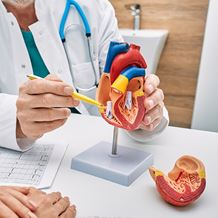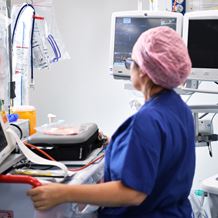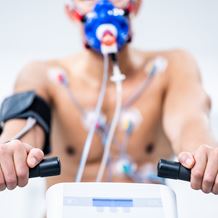
- Home
- Services
- Cardiac Services
- Procedures and Treatments
- Ventricular Assist Device (VAD)
What is ventricular assist device?
A ventricular assist device, also known as a VAD, is a type of pump that is implanted in your heart to help blood circulate around your body. It is attached to one of your lower heart chambers (ventricles) and provides treatment to patients suffering from a weakened heart, or heart failure, by supplying a constant flow of blood. Ventricular assist devices are generally used to help patients that need extra support as they recover from heart surgery, and patients who are waiting for heart transplant surgery. VADs are also used to provide those patients who are not eligible for heart transplant surgery with a better quality of life, and a long-term treatment option. There are different types of VADs available:
- Left Ventricular Assist Device (LVAD) – placed in the left side lower heart chamber and the most common VAD
- Right Ventricular Assist Device (RVAD) – helps to pump blood from the right side of your heart into your lungs
- Biventricular Assist Device – supports both sides of your heart
- Paediatric VADs – smaller devices designed for babies
What does it do?
A ventricular assist device is a pump mechanism that keeps blood circulating around your body. It acts as an artificial part of your heart when it is not quite strong enough to pump enough blood by itself. If your heart is weakened from surgery or you are waiting for heart transplant surgery, your doctor may recommend a ventricular assist device to help your heart function more efficiently, reduce symptoms and improve your quality of life.
How does it work?
The VAD is made up of a pump, controller and power source. The pump has a spinning mechanism that keeps blood moving around from your heart to the rest of your body. It takes over the action of your heart and is operated by a controller. The pump and controller are connected by a cable, and are powered by two separate battery sources which can be worn on a belt or harness. Patients and families are fully informed on how the ventricular assist device works, how to take care of it and what to do in case of an emergency.
Why is it performed?
Ventricular assist devices are typically used to provide cardiac support to patients with a weakened or failing heart as a result of heart surgery, or end stage heart failure. VADs also provide a treatment bridge for patients having heart transplant surgery, or those considering heart transplant surgery. It is an effective procedure to reduce fatigue, increase strength and improve quality of life.
Procedure
Ventricular assist device surgery typically takes between four to six hours. It is performed under general anaesthetic, with medication to help you relax and fall asleep.
- You will be connected to a heart lung bypass machine so that blood circulation is maintained during surgery
- An incision is made in your chest to access your heart
- The ventricular assist device is attached in the appropriate area of your heart
- The chest is closed using wires and stitches
- The heart is restarted
Recovery
You will be monitored in intensive care before transferring on to the cardiac ward. Here you will continue to recover under the experienced care of the VAD nursing team, until your doctor advises you are ready to be discharged home. Patients are supported with a personalised recovery program that includes continued professional care, education, resources and follow-up appointments.
What's next?
If you have been experiencing heart-related symptoms, book an appointment with our cardiac services specialist today.
Our specialists in Cardiac Services
View all specialists





